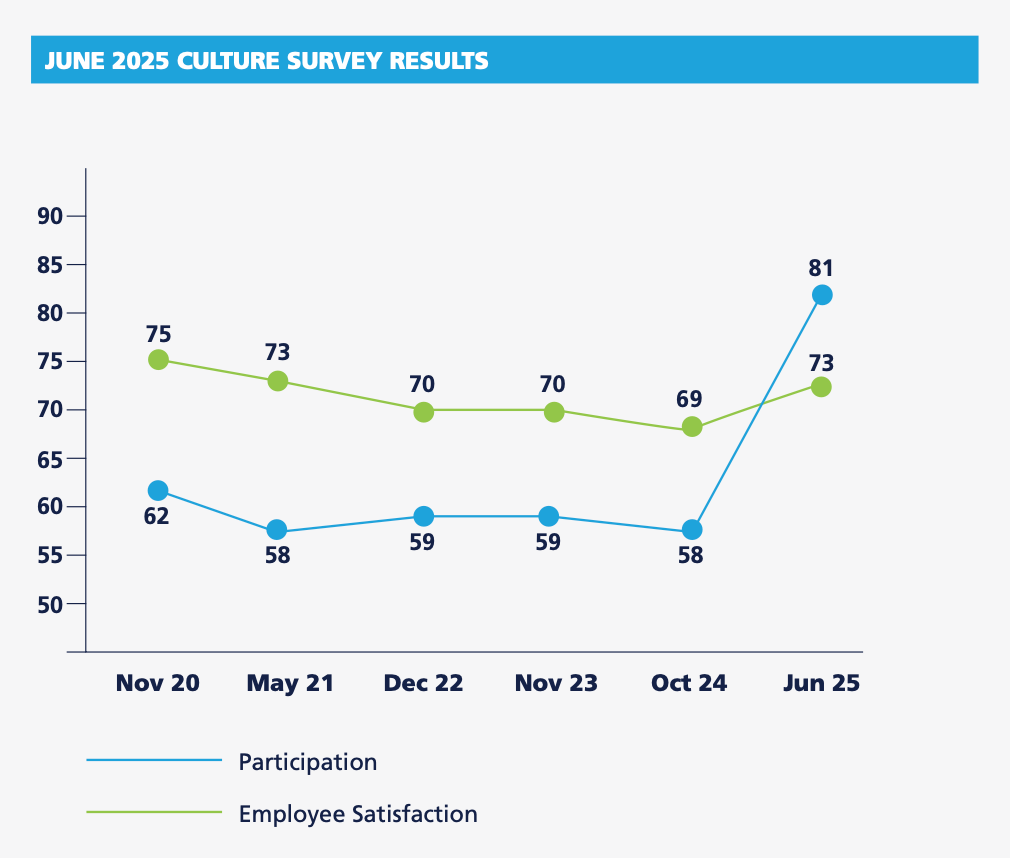Employees
Please click on the tiles below for more information about Essential’s human capital management and DEI initiatives.
Download the ReportHuman Capital Management
Human Capital Management
As a premier infrastructure company, Essential offers a wide array of exciting and challenging opportunities for careers that support our mission to provide natural resources for life.
We recognize our 3,200+ employees are our greatest asset in delivering life’s most essential resources, and we seek to build a talented, skilled and diverse workforce that values teamwork as well as a steadfast commitment to our customers and the environment. The Essential companies, including our Aqua water and Peoples Natural Gas utilities, are committed to providing professional opportunities for career growth, competitive benefits packages and a respectful workplace for every employee across the states we serve. We’re dedicated to creating a culture that empowers employees, where all people feel welcomed, respected and recognized for their contributions. At our core, our team is about respect, integrity and the pursuit of excellence.
Essential’s board of directors takes a keen interest in all aspects of human capital management and recognizes that our ability to attract, retain and develop exceptional talent is a key strategic driver for our organization. The Chief Human Resources Officer regularly presents updates to the board, engaging in strategic discussion with the group regarding various topics from employee engagement and corporate culture to workplace safety.
Employee Health and Safety
Employee Health and Safety
Safety as a Priority
Safety is one of Essential’s primary commitments. Through continuous improvement efforts, we are establishing a high performing and cohesive safety program across our operations. With this program, we proactively manage employee safety risks, support a healthy safety culture and position Essential as a leader among peers through safety prioritization and encouragement of safety ownership at all levels. Our commitment to safety is highlighted through the firm implementation of our safety program, which is flexible and adaptive to meet the varying needs of our complex businesses. The core components of this program include:
Management Commitment: Essential’s leaders are dedicated to supporting safety by incorporating it into corporate targets and goals, such as Essential’s short-term incentive plan (20% weighting). Focusing on these goals not only helps us compare ourselves to industry peers but also helps us to evaluate ourselves with an eye toward our own past performance. With this commitment, we emphasize the outcomes of our safety efforts, which concentrate on striving towards zero injuries and accidents. Senior leadership and safety staff receive weekly reports on both the current week’s incidents and totals for the year.
In 2024, our water and wastewater operations implemented a Senior Leadership Safety Council, Safety Steering Committee, and individual state safety committee meetings, each focused on topics specific to the group as well as communicating between the committees to ensure that front line safety concerns are raised to the appropriate level, including to senior leadership, for a commensurate response. The company’s gas operations had previously undertaken these actions.
Employee Engagement: The basis of our safety culture is an engaged workforce, which is nurtured through positive reinforcement of safety program participation, establishing mechanisms for employees to raise safety concerns, rigorously addressing hazards and thoroughly investigating the root causes of incidents. Not only have our employees internalized their authority to stop work but they are also actively involved in identifying safety solutions. In this way, we promote a speak-up culture and work to proactively address the safety hazards our employees may face. For those identified hazards, we communicate to all levels of our workforce to share lessons learned through safety briefs, newsletters, internal website publications and all-employee video events.
Hazard Identification and Mitigation: Identifying the hazards that our employees face is paramount to maintaining our safety culture, and mitigating these hazards is key to protecting our work family. Therefore, safety hazard analysis is one of the most critical aspects of our safety program and is a focus of our safety program’s audits. Hazard recognition and control are also integral to our incident investigation processes, as is the development of emergency response plans.
Essential employees have access to an anonymous helpline and website, which is available 24/7/365 to confidentially report concerns regarding ethics, compliance or safety issues. We also have a 24/7/365 nurse care line used on all calls other than emergencies that require an immediate emergency room visit. There is a concurrent process to engage our worker’s compensation carrier and an occupational clinic.
Through these hazard identification efforts, we work to control our risks, with management and employees working together to either eliminate hazards or control the threats to employee safety. The effectiveness of the controls is reviewed and improved during root cause analyses of incidents and near misses. We also actively participate in industry safety efforts through the American Gas Association (AGA) and the National Association of Water Companies (NAWC).
A near miss program, internally named Safety Learning Opportunity, spans from the traditional reporting of behavioral near misses to reporting of unsafe conditions, environmental impact potential, potential property damage and last-barrier-challenged incidents (cases where the last point of defense against a hazard was engaged). We have empowered our employees with “stop work authority” to shut down work to reassess any dangers. A safety alert is issued within one week of any injury and this is followed by a more in-depth investigation. These findings are then shared with executive leadership and presented to all managers and supervisors on weekly calls throughout the company.
Safety Training: Another important tool to reduce safety risks in the workplace is through effective safety training. Training is vital for employees to understand the safety practices and expectations that are part of their jobs. Training also empowers employees to recognize safety hazards in the moment and take steps to correct them to prevent a potential injury.
Essential provides safety-related training through multiple methods, from in-person courses to on-the-job training, computer-based lessons and informal safety discussions and meetings. Based on OSHA requirements, the training programs identify work tasks from field hazard assessments and injury and near miss trending from reports to target and address areas where we are seeing injuries or potential injuries before they occur. In this way, Essential’s leadership and management team continues to support and strengthen safety in our workplaces.
Contractor Safety: Across much of our operations, contractors must provide their OSHA 300 log of the previous year’s injury data and their experience modification insurance rating (EMR). Most states hold contractor meetings at least annually to discuss changes, feedback and project information. We also use contractor worksite inspections, sometimes by a third party, to ensure that work practices are safe and match regulations and expectations. Our gas operations utilize a contractor safety program, and we are assessing opportunities for expansion to our water and wastewater operations.
Measuring Safety
No program is complete without effective ways to measure safety performance and make improvements based on these metrics. To accomplish this, Essential monitors safety through a variety of mechanisms. As noted in the table below, safety performance has improved over the past three years across the organization. Over the past three years, there have been no fatalities or OSHA citations.
Lost Time and Restricted Time Injuries (LT/RT)1
| 2024 | 2023 | 2022 | Industry Group Average 2024 |
||
|---|---|---|---|---|---|
| Rate | Essential | 1.1 | 1.2 | 1.2 | NA |
| Water and wastewater | 1.6 | 1.6 | 1.5 | 3.12 | |
| Gas | 0.9 | 0.9 | 1.0 | 1.42 | |
| Count | Essential | 36 | 38 | 39 | N/A |
| Water and wastewater | 23 | 24 | 24 | N/A | |
| Gas | 13 | 14 | 15 | N/A | |
Rate = 200,000 / Hours Worked. Same as DART rate. This data only pertains to full-time Essential employees.
1 Employee injuries resulting in days away from work, job restriction, or transfer.
2 According to the Bureau of Labor Statistics.
3 According to the American Gas Association: Rate = Number of Lost Time and Restricted Duty Injuries.
Employee-Responsible Motor Vehicle Accidents (RVA)
| 2024 | 2023 | 2022 | ||
|---|---|---|---|---|
| Rate | Essential | 2.5 | 2.4 | 2.2 |
| Water and Wastewater | 2.6 | 2.7 | 2.5 | |
| Gas | 2.3 | 2.1 | 1.8 | |
| Count | Essential | 79 | 78 | 68 |
| Water and wastewater | 45 | 47 | 42 | |
| Gas | 34 | 31 | 26 | |
Rate = # RVAs/miles driven*1,000,000
This data only pertains to full-time Essential employees.
Fatalities
| 2024 | 2023 | 2022 |
|---|---|---|
| 0 | 0 | 0 |
OSHA Citations
| 2024 | 2023 | 2022 |
|---|---|---|
| 0 | 0 | 0 |
Near Misses Reported
| 2024 | |
|---|---|
| Essential | 505 |
| Aqua | 467 |
| Peoples | 38 |
Engaging Our Employees
Engaging Our Employees
We believe that our success depends on our employees’ understanding of how their work contributes to Essential’s overall strategy.
We use a variety of communication channels to facilitate open and direct dialogue, including open forums with our executives, monthly town halls, regular engagement surveys, employee newsletters, employee resource groups and regular performance feedback sessions between employees and their supervisors.
Engagement Surveys
Essential’s workforce is surveyed semi-annually to gauge employees’ perspectives on key drivers of engagement and gather feedback.
We have also implemented efforts to build a culture of engagement, including implementing a strategy that ensures all employees are accountable for action planning, increased communication that provides necessary context for changes in a timely manner, leadership development programs and localized participation in post survey action planning.

Summary of Survey Results
Concerted efforts at every level of the organization are being made to create meaningful improvements in team’s work environment.
Employee engagement survey participation up 23%.
Employee satisfaction scores up 6% to a score of 73, closely aligned with the national benchmark of 74.
Notably, all scores of the survey have risen 7 points on average, with 12 out of 17 scores at or above the national average.
Survey Insights
Employees continue to possess a strong sense of purpose/skill.
First- and mid-level people leaders’ sense of empowerment and satisfaction with change communication increased substantially, which correlates to results and actions being managed at the local level.
Employees agree overall that changes and decisions at the immediate teams/departments/functions/state level have had a positive effect on their work experience.
The manager and employee efforts across the organization so far this year are resulting in better employee satisfaction.
CORE SURVEY DIMENSIONS
| Dimensions | Essential | U.S. Benchmark (Comprised of 350 peer firms) |
|---|---|---|
| Employee Satisfaction (happiness) | 73 | 74 |
| Purpose (meaningful work) | 82 | 80 |
| Respectful Treatment | 82 | 81 |
| Feedback (manager provides feedback for improvement) | 82 | 77 |
| Communication – Team (open communication between team members) | 79 | 79 |
| Work Life Balance | 75 | 72 |
Turnover Rates
| Retirements | Voluntary Turnover (Excluding Retirements) | Involuntary Turnover | |
|---|---|---|---|
| Executive/ Sr. Manager Turnover | 0% | 0.1% | 0% |
| Mid-level Manager | 0.6% | 0.7% | 0.3% |
| Professional | 0.1% | 0.9% | 0.3% |
| All Others | 1.4% | 5.2% | 2.4% |
| Total | 2.1% | 6.7% | 2.9% |

